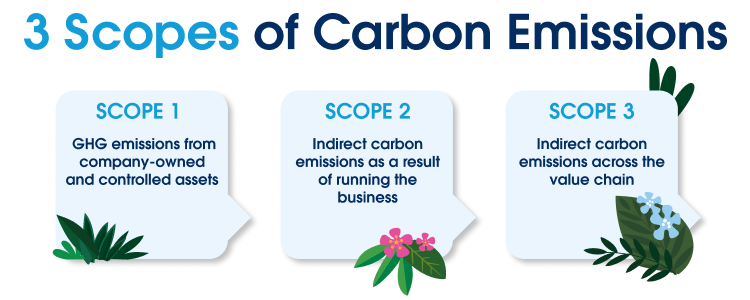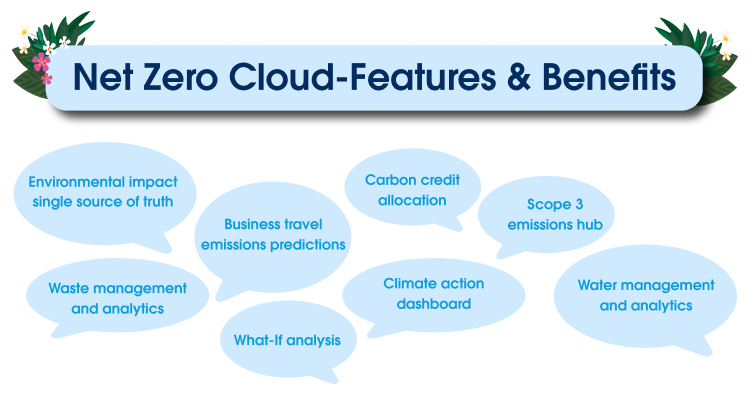As the consequences of climate change become increasingly apparent and tangible, the visible repercussions are prompting India Inc. to realign its priorities toward reducing emissions. Organisations view ESG (Environment, Social and Governance) factors as the first step towards aligning with the global sustainable development goals agenda. This is why, irrespective of industry, geography or size, companies are now allocating more funds to improve their performance against ESG metrics. A key step in this plan is achieving net zero emissions.
And this is where Salesforce Net Zero Cloud can help.
What is Net Zero Cloud?
Salesforce Net Zero Cloud is a complete sustainability management platform that serves as a single source of truth for environmental data. It enables organisations to track emissions across the length and breadth of their operations. With intelligent emissions forecasting, insights, and suggestions that help estimate and reduce emissions, the solution aids long-term sustainability planning.
For companies, becoming net zero implies significantly reducing greenhouse gas (GHG) emissions. To claim net zero, companies must reduce 90-95% of their carbon emissions by 2050. They have to also offset residual emissions (about 5-10%) i.e., those they can’t completely do away with without hampering business operations.
Before you establish ambitious net zero goals or implement climate solutions, identifying your GHG footprint is a necessary step. In simple terms, it involves tracking and evaluating each asset or business process that contributes to the emission of carbon- be it stationary assets, procurement, distribution, manufacturing, marketing, or supply chain management.
How Net Zero Cloud Can Help
Net Zero Cloud helps in the effective management of emissions data, ensuring increased accountability along the way. With Net Zero Cloud, you can:
- View, analyse, and report on your complete environmental footprint
- Work efficiently with your value chain on emissions reduction by bringing in data from diverse sources.
- Easily report on Scope 1, 2 and 3 emissions and share progress with Slack
- Visualise key ESG data with investor-grade dashboards powered by CRM Analytics.
- Take charge of your climate action plan by setting science-based targets
- Intelligently forecast future emissions to stay on track with your sustainability goals
Net Zero Cloud is pre-loaded with reference data sets from various bodies such as the US Environmental Protection Agency, UK Department for Business, Energy & Industrial Strategy, Greenhouse Gas Protocol, and the US Energy Information Administration. Reference data sets enable an easy and effective way to convert consumption data to emissions data.
This award-winning solution democratises tracking and forecasting of carbon emissions, bringing together all stakeholders on a single platform, and providing decision makers with reliable information to accelerate their organisations on the path to net zero. It provides easy-to-understand reports and visualisations for executive decision-making, across all three scopes of emissions.
What Are The Three Scopes Of Emissions?

Scope 1: All greenhouse gas emissions from the company’s owned and controlled assets. This includes emissions from factories, burning of fuels, and leaks from processes. For example, a stationary asset such as a building can contribute to Scope 1 emissions due to fuel combustion.
Scope 2: Indirect carbon emissions – such as the impact of generating the electricity that you have purchased. For example, companies that use electric vehicles for their operations will have electricity generation under scope 2 emissions. Similarly, the emissions generated in heating and cooling also come under this category.
Scope 3: Indirect emissions involved in both upstream and downstream channels of the value chain. Upstream activities include business travel, employee commute, waste generation and processing, transportation and distribution of products used in manufacturing goods. Goods here can be final products, non-production products such as office furniture and supplies, and capital goods such as office buildings, machinery, and other assets. It is, understandably, the most difficult to calculate and forms the majority of an organisation’s greenhouse gas emissions.
Why Net Zero Cloud?
Here are the top reasons why Net Zero Cloud could be a viable sustainability management solution for any climate-conscious company.
- Environmental impact SSOT: Access your single source of truth for all forms of environmental data
- Scope 3 emissions hub: Manage upstream emissions effectively, with a dedicated app for granular tracking of EEIO ( environmentally extended input-output)
- Water management and analytics: Track key metrics around withdrawal, consumption, discharge, risk, and intensity of water-related activities
- Waste management and analytics: Manage waste efficiently, calculate Scope 1, 2, and 3 emissions and get reports on key waste metrics and KPIs
- Carbon credit allocation: Track,manage, and allocate your carbon credits in Net Zero Cloud
- What-if analysis: Conduct real-time scenario planning to evaluate outcomes of potential decisions
- Business travel emissions predictions: Assess your company-wide travel emissions and forecast future emissions from business travel
- Climate action dashboard: A comprehensive carbon footprint dashboard to enable climate-conscious decision making

Business advantages of using Net Zero Cloud
- Competitive advantage: Companies focused on sustainability acquire new target audiences – consumers with environmental concerns and investors looking to boost their environment-friendliness credentials.
- Attracting talent: Recent surveys show that millennials and Gen-Zs are more likely to make career choices based on their ethical beliefs and the company’s environmental credentials.
- Cost reduction: Contrary to perception, sustainability efforts actually reduce costs while improving profits by up to 60%. Environmentally-focused companies are more likely to have higher profitability and productivity than legacy-model companies.
Take decisive steps towards carbon neutrality with Net Zero Cloud
Salesforce achieved 100% renewable energy across its operations in 2021, transforming itself into a net zero company. By combining real-life learnings with innovation and technology, Salesforce created Net Zero Cloud to help companies embark on their net zero emissions journey.
Net Zero Cloud provides cutting-edge tools necessary to determine your carbon footprint, analyse the effects of interventions, reduce emissions, and even furthers the ability of companies to offset their carbon emissions. With real-time emissions data, forecasting, scenario planning, and executive dashboard visualisation, Net Zero Cloud is your organisation’s best ally in achieving its net zero emissions targets.





